Rack of Lamb with Dijon & Panko Crust
This post may contain affiliate links. Read my full disclosure policy.
Who says elegance can’t be easy? Rack of lamb is a dish worthy of special occasions, yet so quick and effortless, it’s doable any night of the week!
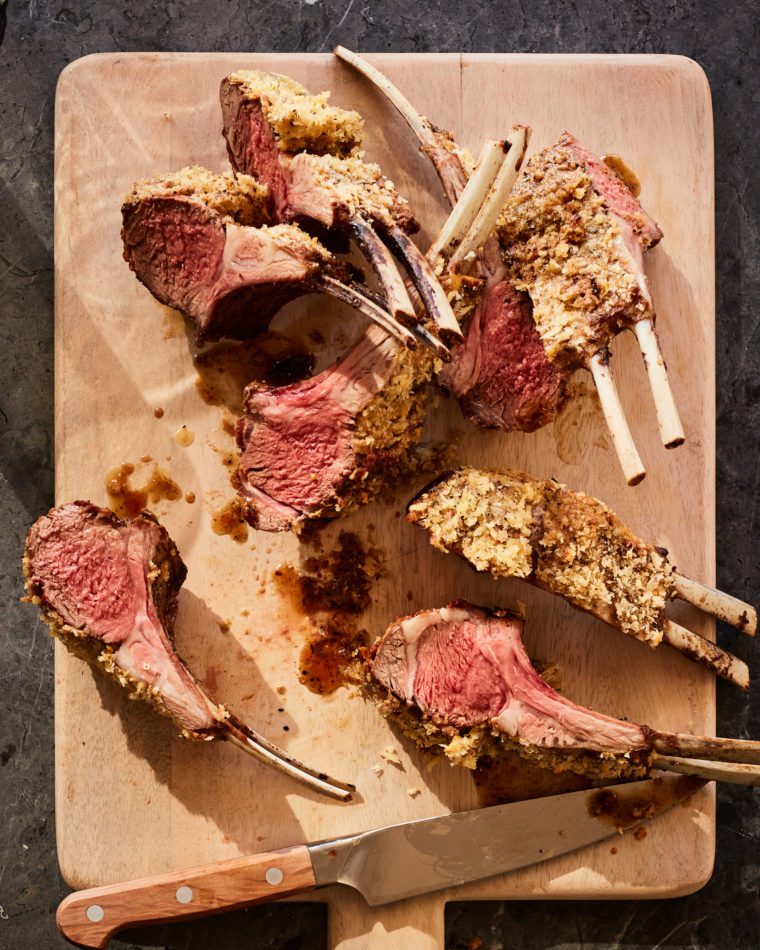
Photo by Johnny Miller (Clarkson Potter, 2021)
Rack of lamb is often thought of as a special occasion dish because of the price, but it’s actually quick and easy to prepare. This classic French preparation is the way I learned to cook it over 20 years ago when I was an apprentice at L’Auberge Chez Francois, and it’s still my favorite method. You sear the racks in a blazing-hot pan, brush them with Dijon mustard, coat them with seasoned panko, and then finish cooking them in the oven. The meat turns out exceptionally flavorful, especially considering how simple the recipe is.
Pair rack of lamb with roasted potatoes, mashed potatoes, or potatoes au gratin. As for vegetables, French green beans, roasted asparagus, or ratatouille would all be delicious options.
Table of Contents
“Made this last night for dinner and it was not only delicious but simple to make.”
What You’ll Need To Make Rack of Lamb with Dijon & Panko Crust
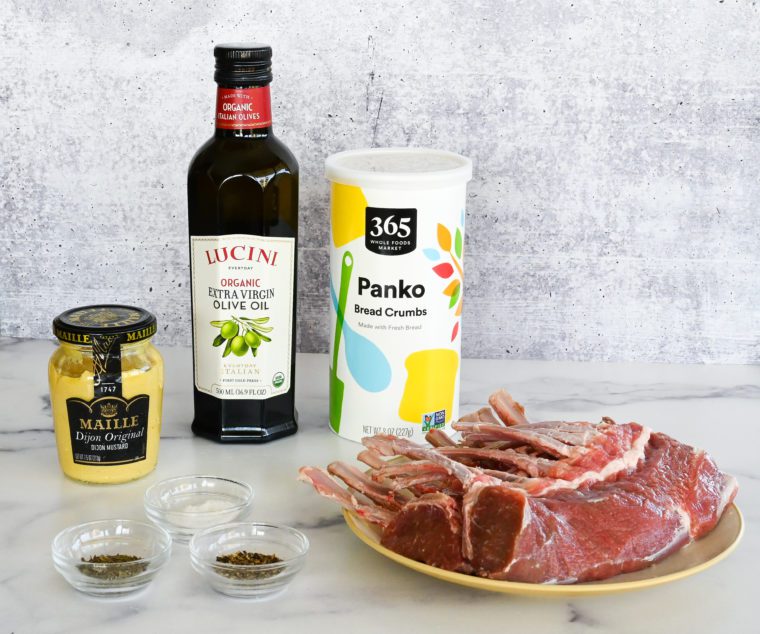
- “Frenched” Lamb Rib Racks: You’ll need two 8-rib racks of lamb for this recipe (count on about 4 ribs per person). When purchasing, look for racks that are already “frenched,” meaning the rib bones are exposed and most of the fat layer has been removed. Even if the racks are frenched, they will likely need a bit more prep to remove additional fat and silver skin. I recommend asking your butcher to do this for you, as it is the only time-consuming part of the recipe, but there are great YouTube tutorials if you have to do it yourself.
- Olive Oil: Used to sear the lamb and also adds richness to the panko coating.
- Dijon Mustard: Flavors the lamb and also helps the panko mixture adhere to the meat. Its sharp, tangy flavor contrasts beautifully with the rich taste of the lamb.
- Panko: Japanese breadcrumbs that create the crust for the lamb. Panko is lighter and crunchier than traditional breadcrumbs, providing a crispy texture contrast to the tender meat.
- Thyme: An aromatic herb that infuses the crust with a subtle, earthy flavor, complementing both the lamb and Dijon mustard.
- Jump to the printable recipe for precise measurements
Step-by-Step Instructions
Step 1: Season the Racks
To begin, sprinkle the lamb evenly with 1 teaspoon each salt and pepper.
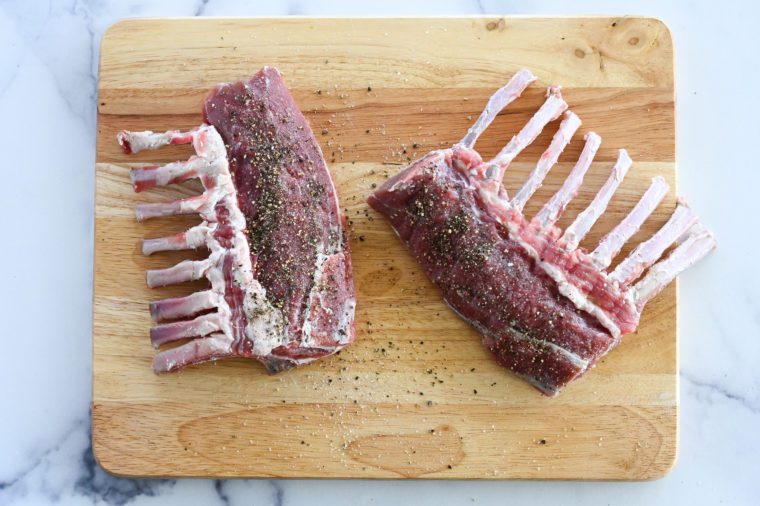
Step 2: Sear the Racks
Heat 2 tablespoons of the oil in a heavy cast-iron or oven-proof stainless-steel skillet over high heat. With your exhaust fan on, sear the lamb for 4 minutes on the first side, or until nicely browned. (The bones of the racks will hang over the edges of the skillet; that’s okay.)
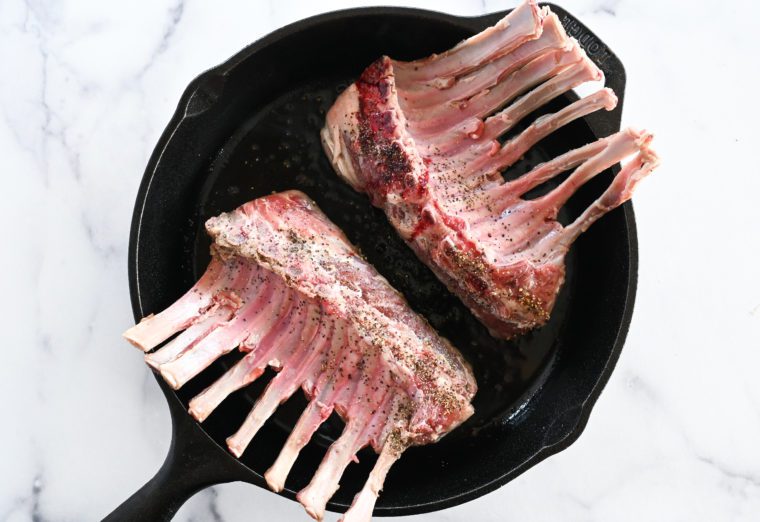
Turn the racks over and sear for 4 minutes more. Don’t worry about searing the ends; they’ll brown in the oven. (Although the lamb is eventually covered with mustard and panko, searing it first caramelizes the surface of the meat and gives it a highly flavorful crust.)
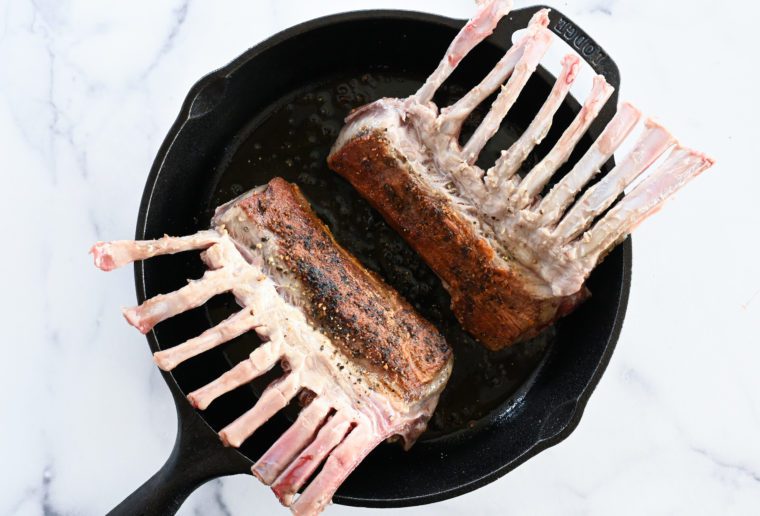
Step 3: Prepare the Panko Coating
Meanwhile, in a small bowl, combine the panko with the remaining teaspoon of oil, the thyme, ¼ teaspoon salt, and a few grinds of black pepper.
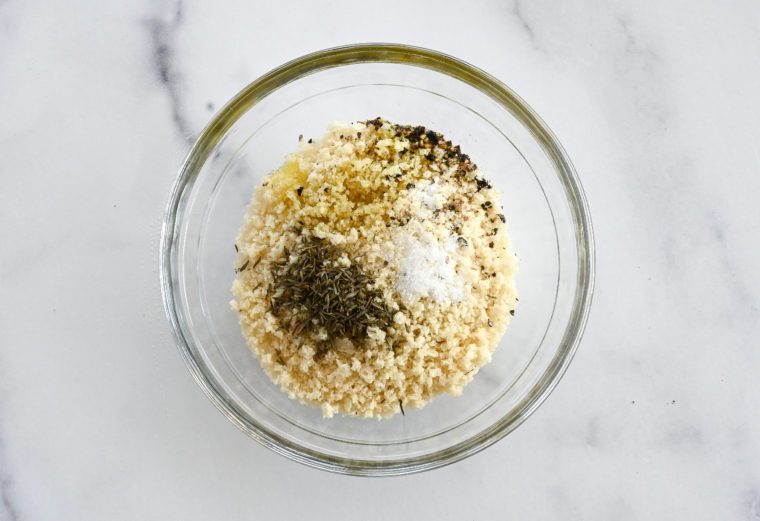
Toss until the panko is well-coated with the oil and seasonings.
Step 4: Coat the Racks with Dijon and Panko Mixture
Using a spoon or brush, spread the mustard all over the meat – you can do this right in the pan (after you’ve removed it from the heat), using tongs to maneuver the racks – then arrange the racks fat/meatier-side up in the skillet.
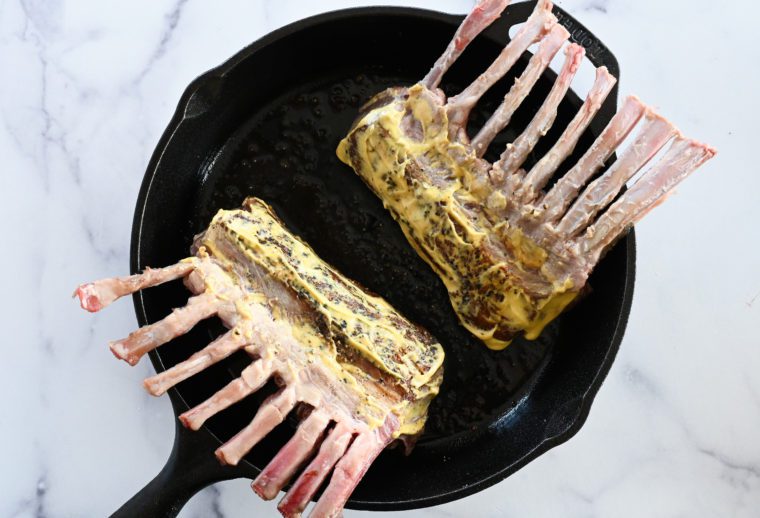 Sprinkle the panko mixture over the mustard coating on the top and sides of the racks (don’t worry about the bottom sides), pressing with your hands to adhere.
Sprinkle the panko mixture over the mustard coating on the top and sides of the racks (don’t worry about the bottom sides), pressing with your hands to adhere.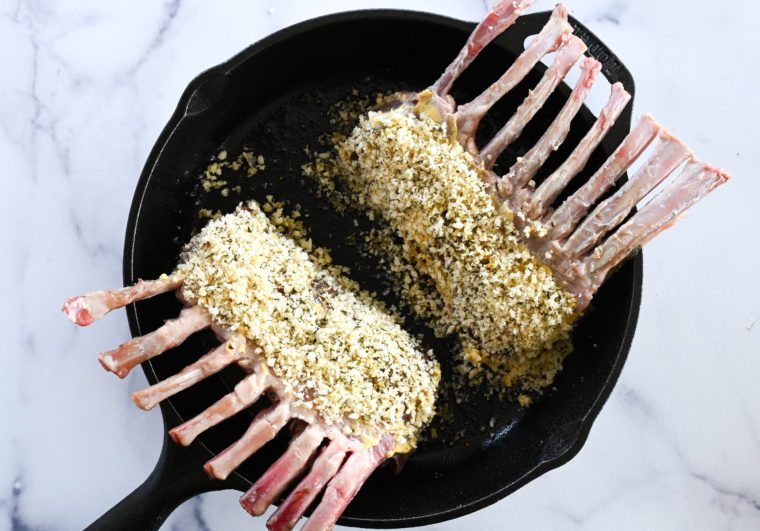
Step 5: Roast in the Oven
Slide the pan into the oven and roast for 15 to 18 minutes, or until a thermometer inserted into the center of one of the roasts registers between 135°F/57°C (medium) and 140°F/60°C (medium-well).
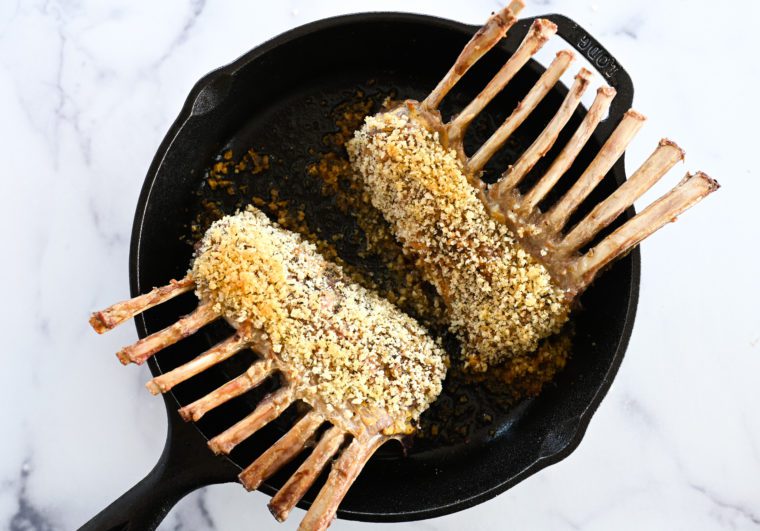
Step 6: Carve and Serve
Transfer the racks to a cutting board, cover with foil to keep warm, and let rest for 10 minutes. Cut into single or double chops.

Frequently Asked Questions
I find that it’s hard to get an accurate read on a meat thermometer for rack of lamb, so I’d suggest using the timing guidelines given here instead of (or at least in addition to) an instant-read thermometer. The USDA recommends cooking lamb to a temperature of at least 145°F/63°C, but many people prefer it rarer. I think an internal temperature of 135°F/57°C (medium) is perfect, as the meat continues to rise several degrees while resting. If you’d prefer, cook a bit longer to meet USDA guidelines.
If you don’t have an ovenproof skillet, simply transfer the racks to a foil-lined baking sheet before roasting. Add a few extra minutes cooking time since the pan won’t be hot.
You May Also Like
Rack of Lamb with Dijon & Panko Crust
Who says elegance can’t be easy? Rack of lamb is a dish worthy of special occasions, yet so quick and effortless, it’s doable any night of the week!
Ingredients
- Two 8-rib "frenched" lamb rib racks (1½ to 2 pounds each), trimmed of fat and silver skin (see note)
- Salt
- Freshly ground black pepper
- 2 tablespoons plus 1 teaspoon olive oil
- 2 tablespoons Dijon mustard
- ½ cup panko
- ¼ teaspoon dried thyme (or ¾ teaspoon finely chopped fresh thyme)
Instructions
- Preheat the oven to 400°F (205°C) and set an oven rack in the middle position.
- Sprinkle the lamb racks all over with 1 teaspoon salt and 1 teaspoon of pepper.
- Heat 2 tablespoons of the oil in a heavy ovenproof skillet (cast-iron or stainless-steel; see note) over high heat. With your exhaust fan on, sear the lamb for 4 minutes on each side, or until nicely browned. Don’t worry about searing the ends; they’ll brown in the oven. (The bones of the racks will hang over the edges of the skillet; that’s okay.)
- Meanwhile, in a small bowl, combine the panko with the remaining teaspoon of oil, the thyme, ¼ teaspoon salt, and a few grinds of black pepper. Toss until the panko is well coated with the oil and seasonings.
- Using a spoon or brush, spread the mustard all over the meat – you can do this right in the pan (after you’ve removed it from the heat), using tongs to maneuver the racks – then arrange the racks fat/meatier-side up in the skillet. Sprinkle the panko mixture over the mustard coating on the top and sides of the racks (don’t worry about the bottom sides), pressing with your hands to adhere.
- Slide the pan into the oven and roast for 15 to 18 minutes, or until a thermometer inserted into the center of one of the roasts registers between 135°F/57°C (medium) and 140°F/60°C (medium-well). Keep in mind that these temperatures account for the fact that the temperature will continue to rise several degrees while the meat rests. Transfer the racks to a cutting board, cover with foil to keep warm, and let rest for 10 minutes. Cut into single or double chops.
- Note: The only time-consuming part of the recipe trimming the fat and silver skin off the racks. I recommend asking your butcher to do this for you, but if you have to do it yourself, this is a good tutorial.
- Note: If you don’t have an ovenproof skillet, transfer the racks to a foil-lined baking sheet before roasting.
- Note: I find that it’s hard to get an accurate read on a meat thermometer for rack of lamb, so I’d suggest using the timing guidelines given here instead of (or at least in addition to) a thermometer. The USDA recommends cooking lamb to a temperature of at least 145°F/63°C, but many people prefer it rarer. I think an internal temperature of 135°F/57°C (medium) is perfect, as the meat continues to rise several degrees while resting. If you'd prefer, cook a bit longer to meet USDA guidelines.
Pair with
Nutrition Information
Powered by ![]()
- Per serving (4 servings)
- Calories: 1,577
- Fat: 145 g
- Saturated fat: 61 g
- Carbohydrates: 6 g
- Sugar: 0 g
- Fiber: 1 g
- Protein: 59 g
- Sodium: 977 mg
- Cholesterol: 302 mg
This website is written and produced for informational purposes only. I am not a certified nutritionist and the nutritional data on this site has not been evaluated or approved by a nutritionist or the Food and Drug Administration. Nutritional information is offered as a courtesy and should not be construed as a guarantee. The data is calculated through an online nutritional calculator, Edamam.com. Although I do my best to provide accurate nutritional information, these figures should be considered estimates only. Varying factors such as product types or brands purchased, natural fluctuations in fresh produce, and the way ingredients are processed change the effective nutritional information in any given recipe. Furthermore, different online calculators provide different results depending on their own nutrition fact sources and algorithms. To obtain the most accurate nutritional information in a given recipe, you should calculate the nutritional information with the actual ingredients used in your recipe, using your preferred nutrition calculator.

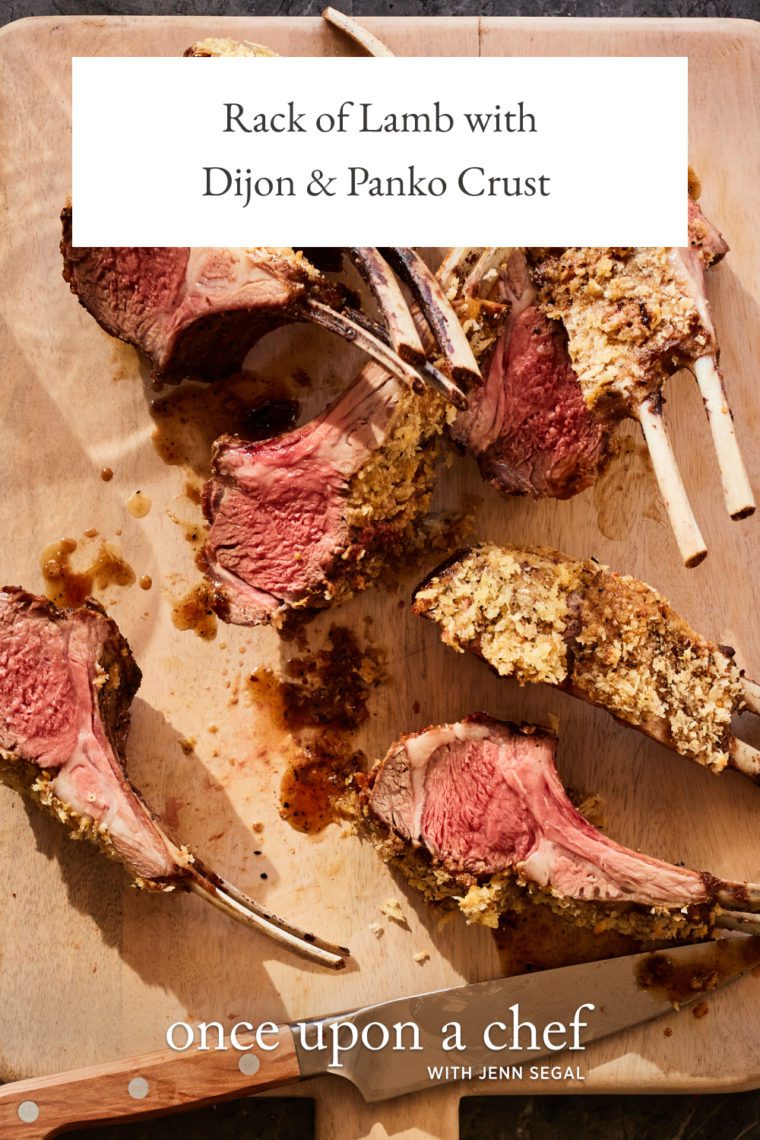
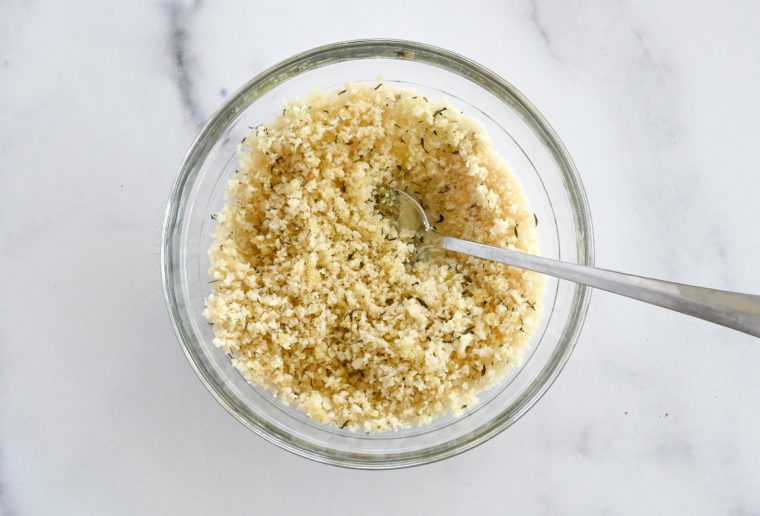
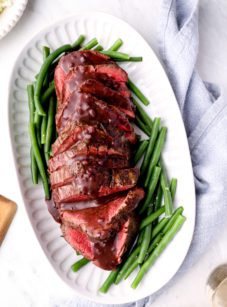
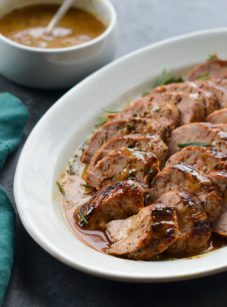
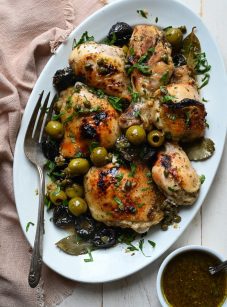
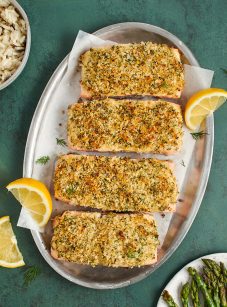
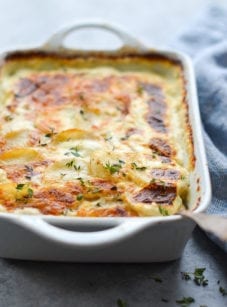
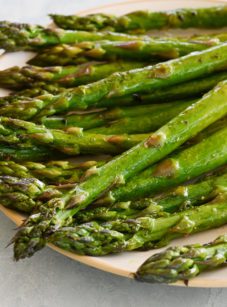
Amazing!! The flavor was off the chain. Definitely adding this the rotation. My husband is not a fan of mustard so he was concerned initially…he loved it.
This recipe is wonderful! I made it last Easter and plan on making it again this weekend. The flavor is awesome and it is so easy to cook, even though it is special occasion worthy.
Jenn – quick question: while I love Dijon and have no problem with it in this recipe, my husband is not the biggest Dijon fan. He can handle a little but not a lot. Would you think it would be okay if I “diluted” the Dijon with olive oil before applying to the lamb? Or would that not be a good idea? I did see your previous comment suggesting mayo but alas, he despises mayo.
Glad you liked it! I don’t think it would work to dilute the Dijon with olive oil, because it would make the mixture too thin/runny. Although your husband doesn’t like mayo, if you diluted the mustard with a bit of mayo, it’s unlikely that he would taste it at all; it would just taste like a milder mustard. Just make sure he’s not in the kitchen when you do it. 😂
My family loved this recipe!! We will definitely make this one again! Thank you!
Will this recipe work for lamb loin chops?
Yes, I think it would. I’d love to hear how they turn out!
I’m planning on making this lamb recipe for dinner guests and my question is ……… would it be possible to brown the lamb before my guests arrive and put the Dijon and Panko on them just before I put them in the oven? I try not to spend a lot of time prepping a meal when guests are here, I like to have some do ahead things done.
Thanks Jenn!
Hi Jillian, are you saying you’d like the sear the lamb and refrigerate it for a while until your guests come? If so, I wouldn’t recommend it from a food safety standpoint. If I’ve misunderstood your question, please let me know.
Jenn is the best . Her recipes are easy to follow. All that I have tried taste great!
Made this last night for dinner and it was not only delicious but simple to make. I make a recipe similar to this for lollipop lamb chops and the panko crust falls off. This was so much easier and quick. Thanks again Jen for another winner!
Hoping to make this for Christmas. Can I use a Gluten Free Panko?
Yep! Enjoy 🙂